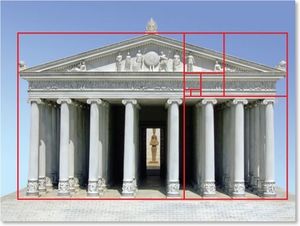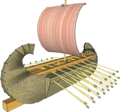Ancient Greece: Difference between revisions
From DT Online
mNo edit summary |
mNo edit summary |
||
| Line 6: | Line 6: | ||
The Greek soldiers were known as [https://en.wikipedia.org/wiki/Hoplite '''Hoplites'''] and their main strategy was to form lines with their shields known as a [https://en.wikipedia.org/wiki/Phalanx '''Phalanx'''] and march forward as single unit. At sea, the Greek warships were | The Greek soldiers were known as [https://en.wikipedia.org/wiki/Hoplite '''Hoplites'''] and their main strategy was to form lines with their shields known as a [https://en.wikipedia.org/wiki/Phalanx '''Phalanx'''] and march forward as single unit. At sea, the Greek warships were '''[[Trireme Model|Triremes]]'''. These were powerful galleys with three tiers of oars,sails and a battering ram at their front. | ||
| Line 26: | Line 26: | ||
A topic on '''Ancient Greece''' could involve work on a variety of short focussed tasks or design make activities. Some are likely to involve models and might include: | A topic on '''Ancient Greece''' could involve work on a variety of short focussed tasks or design make activities. Some are likely to involve models and might include: | ||
* Modelling [https://en.wikipedia.org/wiki/Ancient_Greek_temple '''Greek Temples'''] and other buildings to understand [https://en.wikipedia.org/wiki/Ancient_Greek_architecture '''Greek Architecture''']; | * Modelling [https://en.wikipedia.org/wiki/Ancient_Greek_temple '''Greek Temples'''] and other buildings to understand [https://en.wikipedia.org/wiki/Ancient_Greek_architecture '''Greek Architecture''']; | ||
* | * '''[[Trireme Model|Model Trireme]]'''; | ||
* Model [https://en.wikipedia.org/wiki/Lighthouse_of_Alexandria '''Lighthouse of Alexandria''']; | * Model [https://en.wikipedia.org/wiki/Lighthouse_of_Alexandria '''Lighthouse of Alexandria''']; | ||
* Using [https://en.wikipedia.org/wiki/Platonic_solid '''Platonic solids'''] as the start of the design and make task; | * Using [https://en.wikipedia.org/wiki/Platonic_solid '''Platonic solids'''] as the start of the design and make task; | ||
Latest revision as of 20:00, 12 October 2017
The Ancient Greek empire covered a period between the end of the Mycenaean civilization in 1100BC until the Roman conquest in 146BC. Greece was one of the most important places in the ancient world and Greek culture remained a powerful influence in the Roman Empire. The Greeks called themselves 'Hellenes' and their land was 'Hellas'. The name ‘Greeks’ was given to the people of Greece later by the Romans.
Originally, the area of Greece was made up of several smaller states always in conflict with each other. Eventually they came together to fight off the greater threat posed by invading Persians until, led by Alexander the Great, Greece defeated the Persian Empire.
The Greek soldiers were known as Hoplites and their main strategy was to form lines with their shields known as a Phalanx and march forward as single unit. At sea, the Greek warships were Triremes. These were powerful galleys with three tiers of oars,sails and a battering ram at their front.
Ancient Greece is regarded as the birthplace of modern western civilisation. They were the first civilisation to leave a written history They founded democracy, developed the theatre and made great discoveries in science, mathematics, and technology - and they created the first Olympic Games.
The Ancient Greeks believed in Gods and Goddesses including: Zeus; Poseidon; Athena; Apollo; Aphrodite; Dionysus and Hades. They built Temples to their Gods (e.g. the Parthenon for the Goddess Athena which still stands today). These were quite basic structures surrounded by Columns above which was a sculptured Frieze topped by a triangular shaped area called a Pediment containing more carvings.
The unique style of Greek Architecture has been copied many times and is still an influence in architecture today. The Greeks saw that the universe was ordered and sought to reflect this in their own creations. The proportions of their buildings were based around relationships they found in nature which we know as the Golden Mean. Once designed, actual shapes of building were adapted to ensure they appeared correct by employing various optical illusions (e.g. columns were a slightly larger diameter at the top than the bottom and slightly swelled around their middle such that they appear straight in Perspective).
The Ancient Greeks studied Mathematics as a means of understanding how the world and the universe works. Euclid and Pythagoras are known for their work on Geometry, Archimedes made many discoveries in science and technology while Aristotle studied animals and plants in great detail. Plato, Socrates and Aristotle laid the foundations of western science and philosophy. Hippocrates is regarded the father of modern medicine and the Hippocratic Oath is still used today.
A topic on Ancient Greece could involve work on a variety of short focussed tasks or design make activities. Some are likely to involve models and might include:
- Modelling Greek Temples and other buildings to understand Greek Architecture;
- Model Trireme;
- Model Lighthouse of Alexandria;
- Using Platonic solids as the start of the design and make task;
- Learning about Perspective, Geometry and the Golden Section;
- Exploring Greek inventions such as: Archimedian Screw, Winch, Levers and other Basic Machines.
Subcategories
This category has the following 2 subcategories, out of 2 total.
Pages in category "Ancient Greece"
The following 5 pages are in this category, out of 5 total.
Media in category "Ancient Greece"
The following 5 files are in this category, out of 5 total.
- ParthenonProportions.jpg 508 × 383; 57 KB
- TriremeDims.png 1,649 × 1,194; 157 KB
- TriremeHullAssembly.png 1,766 × 637; 851 KB
- TriremeOutriggerAssembly.png 1,462 × 549; 762 KB
- TriremeSail.png 619 × 578; 319 KB






